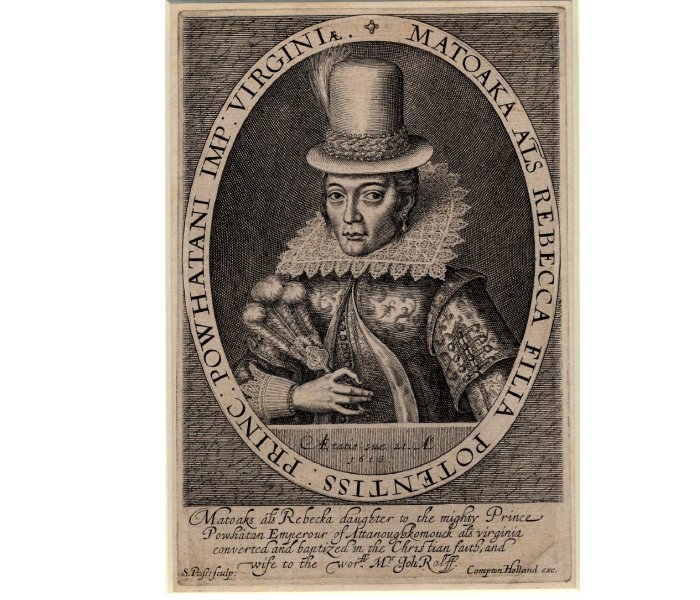MessageToEagle.com – Pocahontas was a Native American woman. Her real name was Matoaka (also known as Amonute). She was called “Pocahontas” as a nickname, which meant “playful one,” because of her lively and curious nature. She was born about 1595 and is today remembered for her association with the colonial settlement at Jamestown, Virginia.
Not much is known about this memorable woman. What we do know was written by others, as none of her thoughts or feelings were ever recorded.
Many have heard about Pocahontas, but her story is not as presented in the animated movie Walt Disney Pictures released in 1995.

Pocahontas was the daughter of the paramount chief Powhatan (1545-1618) who was called “King” or “Chief” Powahatan by the English and led the main political and military power facing the early colonists. At its height, the Powhatan Chiefdom had a population of about 25,000 and included more than 30 Algonquian speaking tribes – each with its own werowance (chief). The Powhatan Indians called their homeland “Tsenacomoco.”
When the English arrived and settled Jamestown in May 1607, Pocahontas was about eleven years old. Pocahontas is most famously linked to the English colonist Captain John Smith, who arrived in Virginia with a hundred other settlers in April 1607. In December 1607, while exploring on the Chickahominy River, Smith was captured by a hunting party led by Powhatan’s younger brother (or close relative) Opechancanough and brought to Powhatan’s capital at Werowocomoco.

Early histories did establish that Pocahontas befriended Smith and the Jamestown colony. Pocahontas often went to the settlement and played games with the boys there.[26] When the colonists were starving, “every once in four or five days, Pocahontas with her attendants brought him [Smith] so much provision that saved many of their lives that else for all this had starved with hunger.”[27] As the colonists expanded their settlement further, the Powhatan felt their lands were threatened, and conflicts arose again.
In late 1609, an injury from a gunpowder explosion forced Smith to return to England for medical care. The English told the Powhatans that Smith was dead. Pocahontas believed that account and hence afterward, stopped visiting Jamestown. Much later, she learned that he was living in England when she traveled there as the wife of John Rolfe.
See also:
Tecumseh: Native American Mystic, Warrior, Hero And Military Leader Of The Shawnee
What Was The Symbolism Behind Native American Feathers?
How Did Native American Indian Chiefs Get Their Names?
Ancient DNA Reveals The Story How Native Americans Were Wiped Out
When Pocahontas was 18 years, she was captured and taken as hostage by the Englishmen and held for ransom. The Englishmen demanded that her father should release all the colonists he held captive.
After her capture, Pocahontas was brought to Jamestown. Eventually, she was probably taken to Henrico, a small English settlement near present-day Richmond. Powhatan, informed of his daughter’s capture and ransom cost, agreed to many of the English demands immediately, to open negotiations. In the meantime, Pocahontas was put under the charge of Reverend Alexander Whitaker, who lived at Henrico. She learned the English language, religion and customs. While not all was strange to Pocahontas, it was vastly different than the Powhatan world.
During her religious instruction, Pocahontas met widower John Rolfe whom she married in 1614. By all English accounts, the two fell in love and wanted to marry. Other sources state she was forced to marry Rolfe. She gave birth to a son named Thomas. Pocahontas converted to Christianity and was baptized “Rebecca.” The marriage led to the “Peace of Pocahontas;” a lull in the inevitable conflicts between the English and Powhatan Indians. The Rolfe family traveled to England in 1616.
In March 1617, the Rolfe family was ready to return to Virginia. After traveling down the Thames River, Pocahontas, seriously ill, had to be taken ashore. In the town of Gravesend, Pocahontas died of an unspecified illness.
Many historians believe she suffered from an upper respiratory ailment, such as pneumonia, while others think she could have died from some form of dysentery. Pocahontas, about twenty-one, was buried at St. George’s Church on March 21, 1617.
John Rolfe returned to Virginia, but left the young ailing Thomas with relatives in England. Within a year, Powhatan died. The “Peace of Pocahontas” began to slowly unravel. Life for her people would never be the same.
MessageToEagle.com






